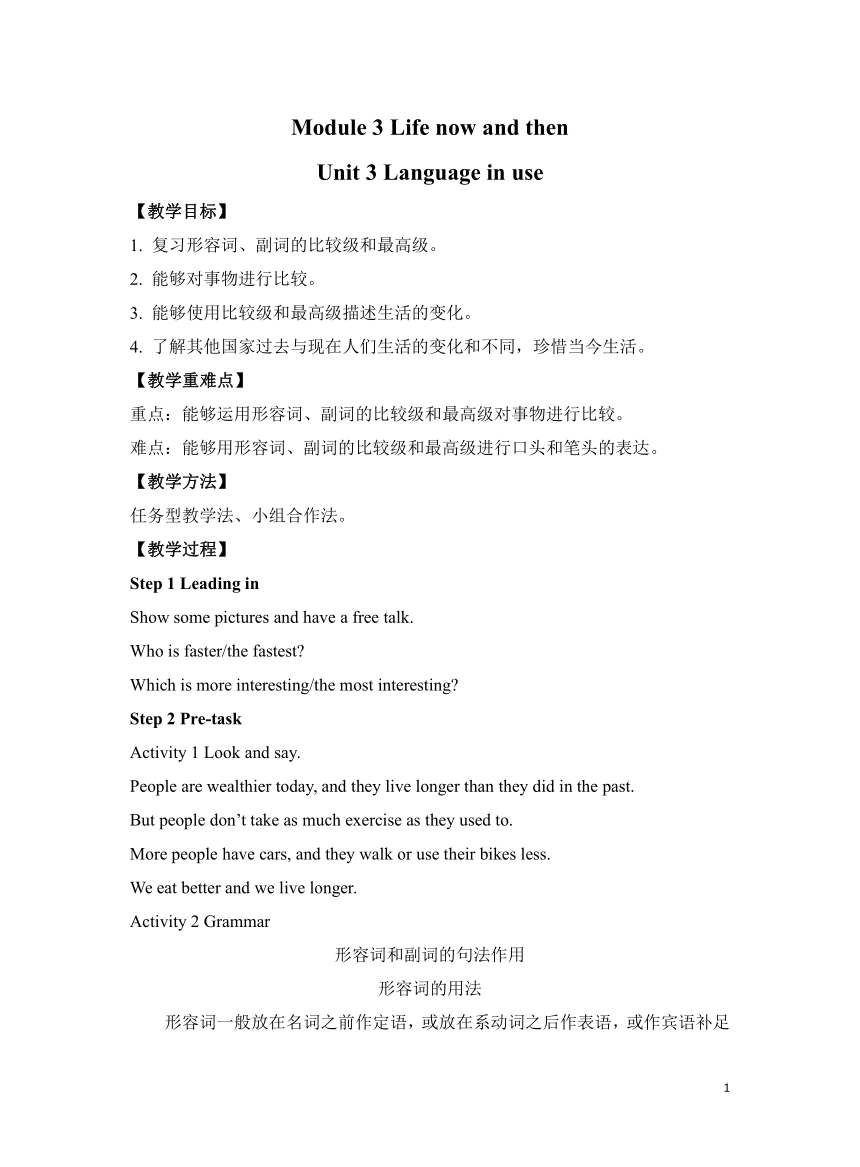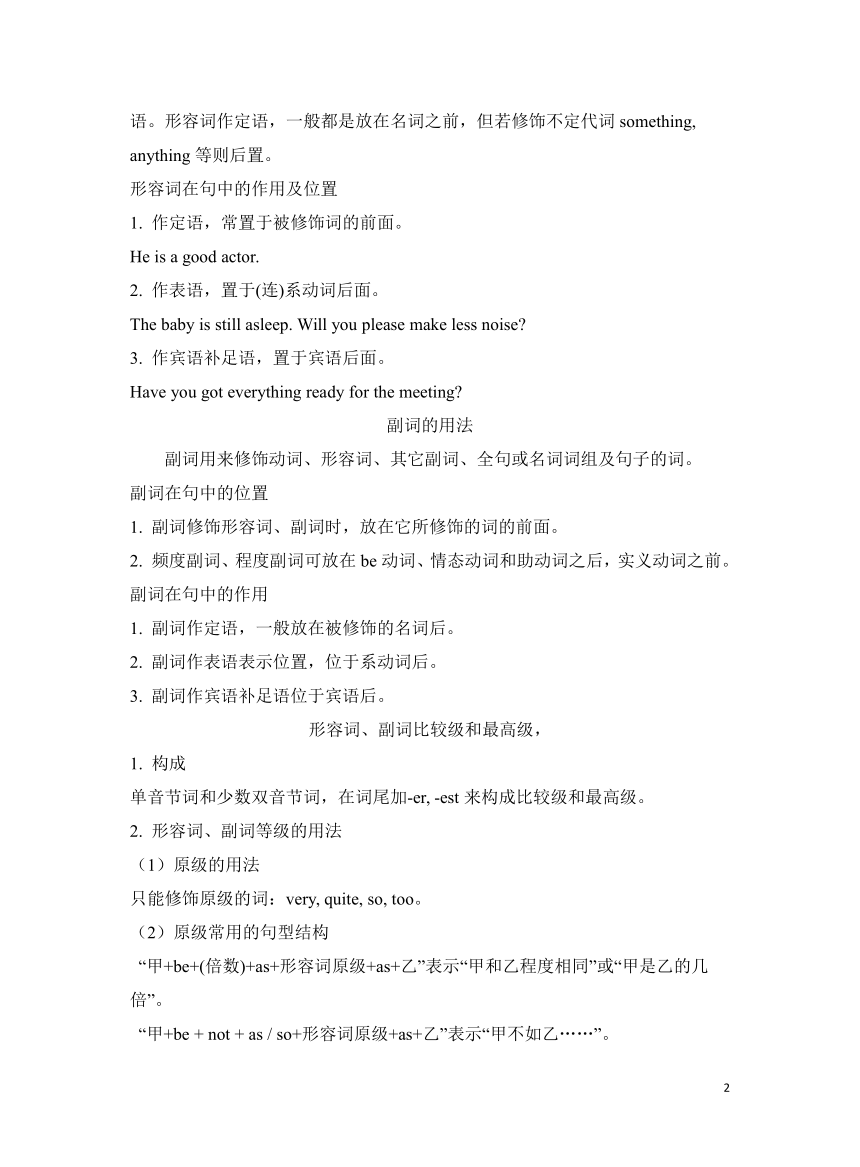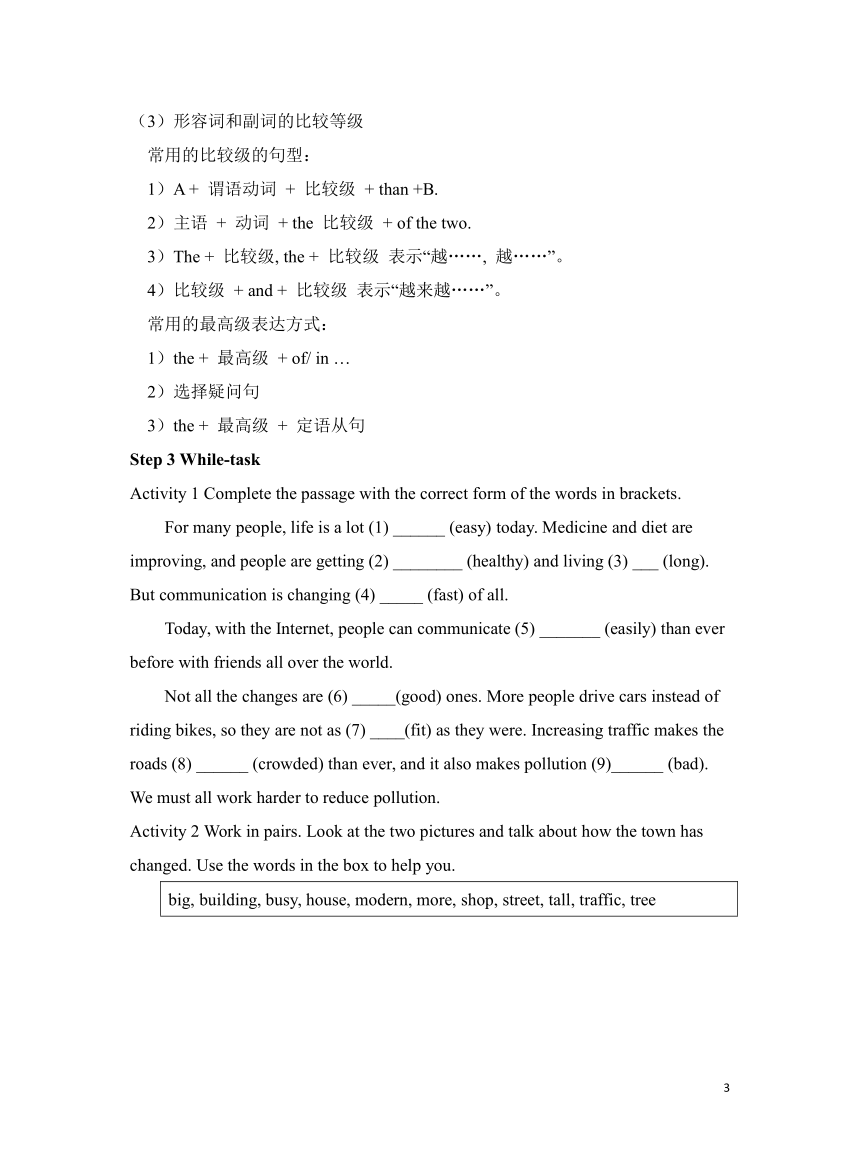初中英语外研版九下Module 3 Unit 3 Language in use. 教案
文档属性
| 名称 | 初中英语外研版九下Module 3 Unit 3 Language in use. 教案 |  | |
| 格式 | doc | ||
| 文件大小 | 1.3MB | ||
| 资源类型 | 教案 | ||
| 版本资源 | 外研版 | ||
| 科目 | 英语 | ||
| 更新时间 | 2023-08-30 17:28:52 | ||
图片预览



文档简介
Module 3 Life now and then
Unit 3 Language in use
【教学目标】
1. 复习形容词、副词的比较级和最高级。
2. 能够对事物进行比较。
3. 能够使用比较级和最高级描述生活的变化。
4. 了解其他国家过去与现在人们生活的变化和不同,珍惜当今生活。
【教学重难点】
重点:能够运用形容词、副词的比较级和最高级对事物进行比较。
难点:能够用形容词、副词的比较级和最高级进行口头和笔头的表达。
【教学方法】
任务型教学法、小组合作法。
【教学过程】
Step 1 Leading in
Show some pictures and have a free talk.
Who is faster/the fastest
Which is more interesting/the most interesting
Step 2 Pre-task
Activity 1 Look and say.
People are wealthier today, and they live longer than they did in the past.
But people don’t take as much exercise as they used to.
More people have cars, and they walk or use their bikes less.
We eat better and we live longer.
Activity 2 Grammar
形容词和副词的句法作用
形容词的用法
形容词一般放在名词之前作定语,或放在系动词之后作表语,或作宾语补足语。形容词作定语,一般都是放在名词之前,但若修饰不定代词something, anything等则后置。
形容词在句中的作用及位置
1. 作定语,常置于被修饰词的前面。
He is a good actor.
2. 作表语,置于(连)系动词后面。
The baby is still asleep. Will you please make less noise
3. 作宾语补足语,置于宾语后面。
Have you got everything ready for the meeting
副词的用法
副词用来修饰动词、形容词、其它副词、全句或名词词组及句子的词。
副词在句中的位置
1. 副词修饰形容词、副词时,放在它所修饰的词的前面。
2. 频度副词、程度副词可放在be动词、情态动词和助动词之后,实义动词之前。
副词在句中的作用
1. 副词作定语,一般放在被修饰的名词后。
2. 副词作表语表示位置,位于系动词后。
3. 副词作宾语补足语位于宾语后。
形容词、副词比较级和最高级,
1. 构成
单音节词和少数双音节词,在词尾加-er, -est来构成比较级和最高级。
2. 形容词、副词等级的用法
(1)原级的用法
只能修饰原级的词:very, quite, so, too。
(2)原级常用的句型结构
“甲+be+(倍数)+as+形容词原级+as+乙”表示“甲和乙程度相同”或“甲是乙的几倍”。
“甲+be + not + as / so+形容词原级+as+乙”表示“甲不如乙……”。
(3)形容词和副词的比较等级
常用的比较级的句型:
1)A + 谓语动词 + 比较级 + than +B.
2)主语 + 动词 + the 比较级 + of the two.
3)The + 比较级, the + 比较级 表示“越……, 越……”。
4)比较级 + and + 比较级 表示“越来越……”。
常用的最高级表达方式:
1)the + 最高级 + of/ in …
2)选择疑问句
3)the + 最高级 + 定语从句
Step 3 While-task
Activity 1 Complete the passage with the correct form of the words in brackets.
For many people, life is a lot (1) ______ (easy) today. Medicine and diet are improving, and people are getting (2) ________ (healthy) and living (3) ___ (long). But communication is changing (4) _____ (fast) of all.
Today, with the Internet, people can communicate (5) _______ (easily) than ever before with friends all over the world.
Not all the changes are (6) _____(good) ones. More people drive cars instead of riding bikes, so they are not as (7) ____(fit) as they were. Increasing traffic makes the roads (8) ______ (crowded) than ever, and it also makes pollution (9)______ (bad). We must all work harder to reduce pollution.
Activity 2 Work in pairs. Look at the two pictures and talk about how the town has changed. Use the words in the box to help you.
big, building, busy, house, modern, more, shop, street, tall, traffic, tree
Activity 3 Complete the sentences with the words or expressions in the box.
heat, more than, seldom, spare, speak up
1. We ________ have time to go on holiday.
2. We do not have much _________ time because we have important exams this year.
3. Never go out in the ______ of the day without a hat.
4. You have to __________ because the students in the back cannot hear you.
5. Mr Smith is __________ a teacher. Most of his pupils think of him as their friend.
Activity 4 Read the email and find three examples that show life was harder in the past than it is today.
Then read the email again. Find sentences that tell us:
1. There was not enough living space for people.
2. Most of the big cities were dirty and unhealthy.
3. Life was harder for children in those times.
Activity 5 Listen and complete the table.
Grandmother Mother
Age to start school
Age to start work
Age to get married
Number of children
Age to stop working
Step 4 Post-task
Activity 1 Write a passage comparing the lives of the speaker’s grandmother and mother in Activity 6.
Activity 2 Around the world
Read and fill in the table.
In the past Modern
Ways
Features
Activity 3 Work in groups. Read the motion of the debate.
Health is more important than wealth.
Now decide who is for the motion and who is against it. You can use some of the following ideas.
Activity 4 Exercise
完成句子。
1. Bob is ______ (young) than Fred but ______ (tall) than Fred.
2. Yingtian is not as ________ (tall) as Yongxian.
3. Almost all the students’ faces are the same but Li Deming looks ______(fat) than before.
4. Which is ________ (heavy), a hen or a chicken
Step 5 Summary
1. We have summarized and consolidated the use of adjectives and adverbs.
2. We have summarized and consolidated the use of comparative degree and superlative degree.
Step 6 Homework
1. Finish the exercises in students’ book.
2. Finish writing the passage comparing their lives in Activity 7.
【板书设计】
一、形容词和副词的句法作用
1. 形容词的用法
形容词一般放在名词之前作定语,或放在系动词之后作表语,或作宾语补足语。形容词作定语,一般都是放在名词之前,但若修饰不定代词 something, anything等则后置。
2. 形容词在句中的作用及位置
(1)作定语,常置于被修饰词的前面。
(2)作表语,置于(连)系动词后面。
(3)作宾语补足语,置于宾语后面。
二、副词的用法
1. 副词用来修饰动词、形容词、其它副词、全句或名词词组及句子的词。
2. 副词在句中的位置
(1)副词修饰形容词、副词时,放在它所修饰的词的前面。
(2)频度副词、程度副词可放在be动词、情态动词和助动词之后,实义动词之前。
3. 副词在句中的作用
(1)副词作定语,一般放在被修饰的名词后。
(2)副词作表语表示位置,位于系动词后。
(3)副词作宾语补足语位于宾语后。
三、形容词、副词比较级和最高级
1. 构成
单音节词和少数双音节词, 在词尾加-er, -est来构成比较级和最高级。
2. 形容词、副词等级的用法
(1)原级的用法
只能修饰原级的词:very, quite, so, too。
(2)原级常用的句型结构
“甲+be+(倍数)+as+形容词原级+as+乙”表示“甲和乙程度相同”或“甲是乙的几倍”。
“甲+be + not + as / so+形容词原级+as+乙”表示“甲不如乙……”。
3. 形容词和副词的比较等级
(1)常用的比较级的句型:
1)A + 谓语动词 + 比较级 + than +B.
2)主语 + 动词 + the 比较级 + of the two.
3)The + 比较级, the + 比较级 表示“越……, 越……”。
4) 比较级 + and + 比较级 表示“越来越……”。
(2)常用的最高级表达方式:
1)the + 最高级 + of/ in …
2)选择疑问句
3)the + 最高级 + 定语从句
1
Unit 3 Language in use
【教学目标】
1. 复习形容词、副词的比较级和最高级。
2. 能够对事物进行比较。
3. 能够使用比较级和最高级描述生活的变化。
4. 了解其他国家过去与现在人们生活的变化和不同,珍惜当今生活。
【教学重难点】
重点:能够运用形容词、副词的比较级和最高级对事物进行比较。
难点:能够用形容词、副词的比较级和最高级进行口头和笔头的表达。
【教学方法】
任务型教学法、小组合作法。
【教学过程】
Step 1 Leading in
Show some pictures and have a free talk.
Who is faster/the fastest
Which is more interesting/the most interesting
Step 2 Pre-task
Activity 1 Look and say.
People are wealthier today, and they live longer than they did in the past.
But people don’t take as much exercise as they used to.
More people have cars, and they walk or use their bikes less.
We eat better and we live longer.
Activity 2 Grammar
形容词和副词的句法作用
形容词的用法
形容词一般放在名词之前作定语,或放在系动词之后作表语,或作宾语补足语。形容词作定语,一般都是放在名词之前,但若修饰不定代词something, anything等则后置。
形容词在句中的作用及位置
1. 作定语,常置于被修饰词的前面。
He is a good actor.
2. 作表语,置于(连)系动词后面。
The baby is still asleep. Will you please make less noise
3. 作宾语补足语,置于宾语后面。
Have you got everything ready for the meeting
副词的用法
副词用来修饰动词、形容词、其它副词、全句或名词词组及句子的词。
副词在句中的位置
1. 副词修饰形容词、副词时,放在它所修饰的词的前面。
2. 频度副词、程度副词可放在be动词、情态动词和助动词之后,实义动词之前。
副词在句中的作用
1. 副词作定语,一般放在被修饰的名词后。
2. 副词作表语表示位置,位于系动词后。
3. 副词作宾语补足语位于宾语后。
形容词、副词比较级和最高级,
1. 构成
单音节词和少数双音节词,在词尾加-er, -est来构成比较级和最高级。
2. 形容词、副词等级的用法
(1)原级的用法
只能修饰原级的词:very, quite, so, too。
(2)原级常用的句型结构
“甲+be+(倍数)+as+形容词原级+as+乙”表示“甲和乙程度相同”或“甲是乙的几倍”。
“甲+be + not + as / so+形容词原级+as+乙”表示“甲不如乙……”。
(3)形容词和副词的比较等级
常用的比较级的句型:
1)A + 谓语动词 + 比较级 + than +B.
2)主语 + 动词 + the 比较级 + of the two.
3)The + 比较级, the + 比较级 表示“越……, 越……”。
4)比较级 + and + 比较级 表示“越来越……”。
常用的最高级表达方式:
1)the + 最高级 + of/ in …
2)选择疑问句
3)the + 最高级 + 定语从句
Step 3 While-task
Activity 1 Complete the passage with the correct form of the words in brackets.
For many people, life is a lot (1) ______ (easy) today. Medicine and diet are improving, and people are getting (2) ________ (healthy) and living (3) ___ (long). But communication is changing (4) _____ (fast) of all.
Today, with the Internet, people can communicate (5) _______ (easily) than ever before with friends all over the world.
Not all the changes are (6) _____(good) ones. More people drive cars instead of riding bikes, so they are not as (7) ____(fit) as they were. Increasing traffic makes the roads (8) ______ (crowded) than ever, and it also makes pollution (9)______ (bad). We must all work harder to reduce pollution.
Activity 2 Work in pairs. Look at the two pictures and talk about how the town has changed. Use the words in the box to help you.
big, building, busy, house, modern, more, shop, street, tall, traffic, tree
Activity 3 Complete the sentences with the words or expressions in the box.
heat, more than, seldom, spare, speak up
1. We ________ have time to go on holiday.
2. We do not have much _________ time because we have important exams this year.
3. Never go out in the ______ of the day without a hat.
4. You have to __________ because the students in the back cannot hear you.
5. Mr Smith is __________ a teacher. Most of his pupils think of him as their friend.
Activity 4 Read the email and find three examples that show life was harder in the past than it is today.
Then read the email again. Find sentences that tell us:
1. There was not enough living space for people.
2. Most of the big cities were dirty and unhealthy.
3. Life was harder for children in those times.
Activity 5 Listen and complete the table.
Grandmother Mother
Age to start school
Age to start work
Age to get married
Number of children
Age to stop working
Step 4 Post-task
Activity 1 Write a passage comparing the lives of the speaker’s grandmother and mother in Activity 6.
Activity 2 Around the world
Read and fill in the table.
In the past Modern
Ways
Features
Activity 3 Work in groups. Read the motion of the debate.
Health is more important than wealth.
Now decide who is for the motion and who is against it. You can use some of the following ideas.
Activity 4 Exercise
完成句子。
1. Bob is ______ (young) than Fred but ______ (tall) than Fred.
2. Yingtian is not as ________ (tall) as Yongxian.
3. Almost all the students’ faces are the same but Li Deming looks ______(fat) than before.
4. Which is ________ (heavy), a hen or a chicken
Step 5 Summary
1. We have summarized and consolidated the use of adjectives and adverbs.
2. We have summarized and consolidated the use of comparative degree and superlative degree.
Step 6 Homework
1. Finish the exercises in students’ book.
2. Finish writing the passage comparing their lives in Activity 7.
【板书设计】
一、形容词和副词的句法作用
1. 形容词的用法
形容词一般放在名词之前作定语,或放在系动词之后作表语,或作宾语补足语。形容词作定语,一般都是放在名词之前,但若修饰不定代词 something, anything等则后置。
2. 形容词在句中的作用及位置
(1)作定语,常置于被修饰词的前面。
(2)作表语,置于(连)系动词后面。
(3)作宾语补足语,置于宾语后面。
二、副词的用法
1. 副词用来修饰动词、形容词、其它副词、全句或名词词组及句子的词。
2. 副词在句中的位置
(1)副词修饰形容词、副词时,放在它所修饰的词的前面。
(2)频度副词、程度副词可放在be动词、情态动词和助动词之后,实义动词之前。
3. 副词在句中的作用
(1)副词作定语,一般放在被修饰的名词后。
(2)副词作表语表示位置,位于系动词后。
(3)副词作宾语补足语位于宾语后。
三、形容词、副词比较级和最高级
1. 构成
单音节词和少数双音节词, 在词尾加-er, -est来构成比较级和最高级。
2. 形容词、副词等级的用法
(1)原级的用法
只能修饰原级的词:very, quite, so, too。
(2)原级常用的句型结构
“甲+be+(倍数)+as+形容词原级+as+乙”表示“甲和乙程度相同”或“甲是乙的几倍”。
“甲+be + not + as / so+形容词原级+as+乙”表示“甲不如乙……”。
3. 形容词和副词的比较等级
(1)常用的比较级的句型:
1)A + 谓语动词 + 比较级 + than +B.
2)主语 + 动词 + the 比较级 + of the two.
3)The + 比较级, the + 比较级 表示“越……, 越……”。
4) 比较级 + and + 比较级 表示“越来越……”。
(2)常用的最高级表达方式:
1)the + 最高级 + of/ in …
2)选择疑问句
3)the + 最高级 + 定语从句
1
同课章节目录
- Module 1 Travel
- Unit 1 We toured the city by bus and by taxi
- Unit 2 It's a long story.
- Unit 3 Language in use
- Module 2 Education
- Unit 1 They don't sit in rows.
- Unit 2 What do I like best about school?
- Unit 3 Language in use
- Module 3 Life now and then
- Unit 1 They sometimes work harder.
- Unit 2 I think life is better today.
- Unit 3 Language in use.
- Module 4 Rules and suggestions
- Unit 1 You must be careful of falling stones.
- Unit 2 we must keep the camp clean.
- Unit 3 Language in use.
- Revison A
- Module 5 Look after yourself
- Unit 1 We'd better get you to hospital.
- Unit 2 Get off the sofa!
- Unit 3 Language in use.
- Module 6 Eating togethe
- Unit 1 When is the school-leavers' party?
- Unit 2 Knives and forks are used for most Western
- Unit 3 Language in use
- Module 7 English for you and me
- Unit 1 Have you ever been to an English corner?
- Unit 2 We all own English.
- Unit 3 Language in use
- Module 8 My future life
- Unit 1 Here's to our friendship and the future
- Unit 2 I know that you will be better at maths.
- Unit 3 Language in use
- Revison B
